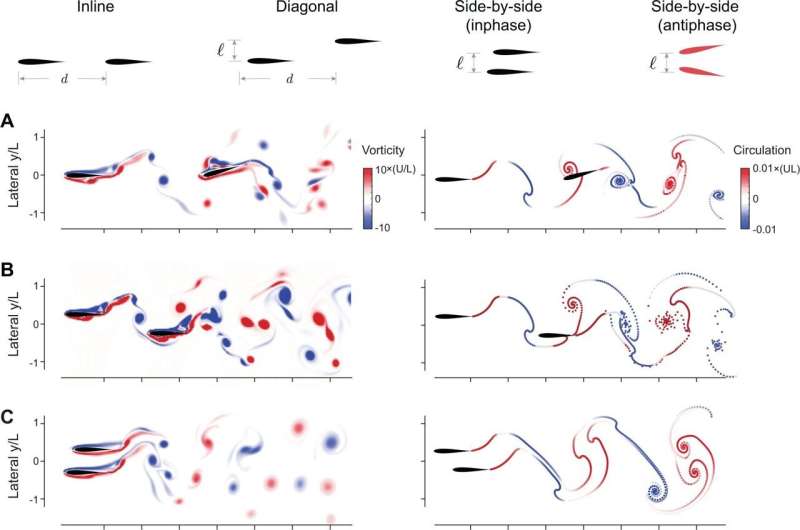This article has been reviewed according to Science X's editorial process and policies. Editors have highlighted the following attributes while ensuring the content's credibility:
fact-checked
peer-reviewed publication
trusted source
proofread
Simulations of swimming fish suggest fish may naturally prefer to compete—not cooperate—during swimming

Researchers have shown how different swimming formations may save fish energy and suggest that they only switch positions to save energy for the group when under pressure.
The study, published as a Reviewed Preprint in eLife, is described as of fundamental importance by the editors, providing new insights into the energy-preservation parameters among schooling fish. The strength of evidence supporting the observations about leading and lagging fish dynamics is said to be convincing.
"Flow interactions are thought to allow swimming and flying animals to save energy when moving in groups, but measuring these energy savings is challenging," says co-lead author Sina Heydari, a postdoctoral researcher at the Department of Aerospace and Mechanical Engineering, University of Southern California, US.
"Although researchers have proposed mechanisms for how each different swimming configuration saves energy, there has been no comparison, to date, of the efficiencies of different configurations relative to each other."
To address this, the researchers used a computational model that captured the hydrodynamic features of single and pairs of swimming fish, representing each fish as a free-swimming hydrofoil undergoing oscillations at its leading edge. The model was then used to analyze how flow interactions cause flapping swimmers all heading in the same direction to self-organize.
When fish in a school move 'in-phase,' their movements are synchronized such that they appear to move as a single, cohesive unit. When schooling fish move 'anti-phase,' their movements are out of sync, creating a wave-like pattern within the school, where the motion of each fish is counterbalanced by the motion of another. Both patterns have been suggested to help with efficient swimming, based on the environmental conditions.
The team found that when schools of fish self-organize into a side-by-side formation and flap in-phase, they share the hydrodynamic benefits equally. However, contrary to some previous reports, they found that when the fish flap in an anti-phase manner, it increases the energy demand to a higher level than if they were swimming alone.
By contrast, in tandem formations (either inline or diagonal) where there's a leader and a follower, the hydrodynamic benefits are gained entirely by the follower.
By simulating the flow dynamics of different formations, the model provides information that can be applied as a predictive tool to both simulation and experimental data. Indeed, the team used this approach to explain the mechanisms leading to scattering in larger groups of inline swimmers and to predict when the wake of a leading group of swimmers offers no energetic benefits to the fish that follow.
They found that as the number of swimmers increases, side-by-side formations remain robust, but inline formations become unstable beyond a critical number of swimmers.
The simulations, together with data from previous experiments, also hint at an intriguing connection between flow physics and social traits such as greed and cooperation. Experiments have shown that, when challenged to sustain high swimming speeds, fish rearrange themselves in a side-by-side pattern as the speed increases.
This study found that side-by-side formations provide the fairest distribution of effort, suggesting that the fish are forced to cooperate when challenged by a strong background current.
In the absence of this challenge, they position themselves spatially as they please, without much consideration to equal sharing of hydrodynamic benefits. Indeed, in tandem, inline formations, the flows generated present serious impediments for additional swimmers to join the line downstream.
"We could call these formations greedy, leaving no resources in the environment for trailing swimmers," says co-lead author Haotian Hang, a Ph.D. candidate at the Department of Aerospace and Mechanical Engineering, University of Southern California. "This, together with our interpretation that cooperation to achieve equitable sharing of hydrodynamic benefits is forced, not innate, raises an interesting hypothesis: that dynamic repositioning of members within the school is driven by greed and competition, rather than cooperation."
eLife's editors conclude that this study provides exciting insights into energetic coupling with respect to group swimming dynamics, but that further clarification regarding degrees of freedom and parameter ranges in the model would strengthen the findings further.
"Understanding how the spatial arrangement of individuals within a group influences energetic costs of movement provides insights into the evolution of social structures, resource allocation and the fitness of each individual when it comes to foraging, mating and evading predators," says senior author Eva Kanso, Zohrab A. Kaprielian Fellow in Engineering, and Professor of Aerospace and Mechanical Engineering at the University of Southern California.
"It could also be used to guide the design of bioinspired engineering systems such as swarms of autonomous robotic vehicles underwater or in flight, which collaborate to achieve a desired task in the most efficient way."
More information: Sina Heydari et al, Mapping Spatial Patterns to Energetic Benefits in Groups of Flow-coupled Swimmers, eLife (2024). DOI: 10.7554/eLife.96129.1
Journal information: eLife
Provided by eLife



















